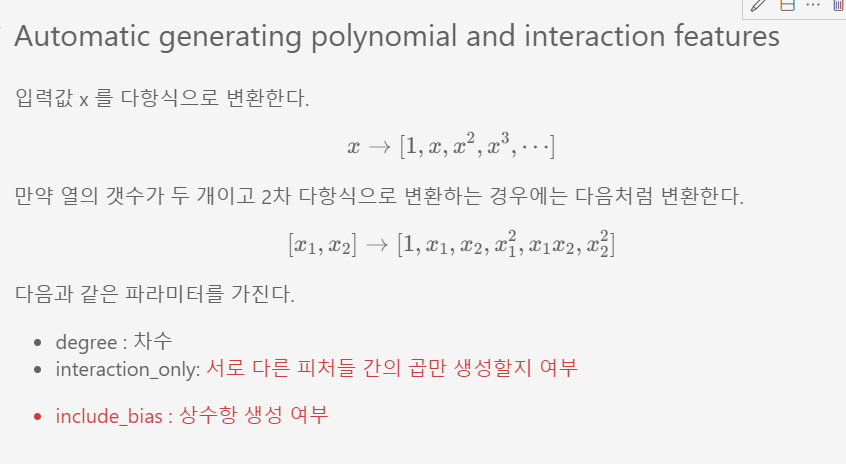AI·빅데이터 융합 경영학 Study Note
[ML수업] 8주차 실습6: feature engineering- Feature Generation 본문
## 6. Feature Generation ###
- 그룹별 summary: Ex) state는 고객이 위치한 36개 주를 나타냄 => 주별로 평균 cost를 계산하여 새로운 feature 생성
- 기존 feature 간의 결합: Ex) 1인당 견적을 계산
- 개별 feature 의 함수적 변환: Ex) np.log, np.sqrt, np.square 등을 사용
- 상호작용과 다항식 추가: 아래 참

# 이전에 배우고 실행했던 코드
import pandas as pd
import numpy as np
from sklearn.datasets import load_breast_cancer
from sklearn.model_selection import train_test_split
from sklearn.svm import SVC
from sklearn.preprocessing import PowerTransformer
from sklearn.feature_selection import SelectKBest
cancer = load_breast_cancer()
X_train, X_test, y_train, y_test = train_test_split(cancer.data, cancer.target, random_state=0)
scaler = PowerTransformer(standardize=True)
X_train_sc3 = scaler.fit(X_train).transform(X_train)
X_test_sc3 = scaler.transform(X_test)
svm = SVC(random_state=0)from sklearn.preprocessing import PolynomialFeatures
X = np.arange(1,7).reshape(3, 2); Xpoly = PolynomialFeatures(3)
poly.fit_transform(X)# 코드 추가
df = pd.DataFrame(poly.fit_transform(X)); df.columns=poly.get_feature_names_out()# 코드 변경
poly = PolynomialFeatures(interaction_only=True, include_bias=False)
poly.fit_transform(X)
'''
array([[ 1., 2., 2.],
[ 3., 4., 12.],
[ 5., 6., 30.]])
'''poly.get_feature_names_out()
#array(['x0', 'x1', 'x0 x1'], dtype=object)# 코드 수정
print(X_train_sc3.shape)
poly = PolynomialFeatures(2, include_bias=False)
X_train_sc3_poly = poly.fit_transform(X_train_sc3)
X_test_sc3_poly = poly.transform(X_test_sc3)
print(X_train_sc3_poly.shape, X_test_sc3_poly.shape)
svm.fit(X_train_sc3_poly, y_train).score(X_test_sc3_poly, y_test)
'''
(426, 30)
(426, 495) (143, 495)
0.9370629370629371
'''#### feature generation + feature selection
select2 = SelectKBest(k=20)
X_train_sc3_poly_fs2 = select2.fit(X_train_sc3_poly, y_train).transform(X_train_sc3_poly)
X_test_sc3_poly_fs2 = select2.transform(X_test_sc3_poly)
print(X_train_sc3_poly_fs2.shape)
svm.fit(X_train_sc3_poly_fs2, y_train).score(X_test_sc3_poly_fs2, y_test)
'''
(426, 20)
0.993006993006993
'''mask = select2.get_support()
np.array(poly.get_feature_names_out())[mask]
'''
array(['x0', 'x1', 'x2', 'x3', 'x5', 'x6', 'x7', 'x10', 'x12', 'x13',
'x17', 'x20', 'x21', 'x22', 'x23', 'x24', 'x25', 'x26', 'x27',
'x3 x10'], dtype=object)
'''
(참고)
#### Kaggle Competition에서 자주 사용되는 feature 생성방법(아래 pdf 참조)
<font color='black'><p>
- https://drive.google.com/open?id=1HDZc1mDvtmpjg9YPpUN0koHeAiqTAHRw
'AI·ML' 카테고리의 다른 글
| [ML수업] 10주차 실습2: Hyperparameter Tuning using Pipeline+Optuna 예시 코드 (0) | 2023.11.21 |
|---|---|
| [ML수업] 10주차 실습1: pipeline_basics (0) | 2023.11.21 |
| [ML수업] 8주차 실습5: feature engineering- Dimensionality Reduction (차원 축소) (0) | 2023.11.21 |
| [ML수업] 8주차 실습4: feature engineering- Feature Selection (0) | 2023.11.21 |
| [ML수업] 8주차 실습3: feature engineering- Numerical Feature Transformation (수치형) (0) | 2023.11.21 |




